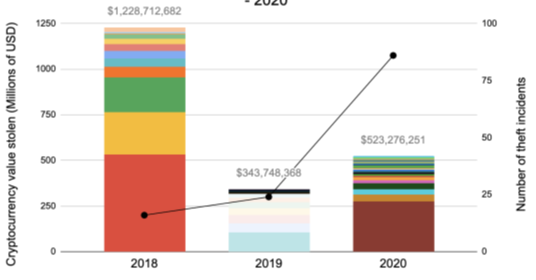Theft in the cryptocurrency environment

We usually associate the cryptocurrency environment with advanced security measures to secure financial resources. There are even companies that offer cryptocurrency holders advanced methods of securing their wealth through military technology. Nevertheless, the problem of theft is not a foreign topic in the cryptocurrency community.
The graph above shows the size of cryptocurrency theft over a period of 3 years. Different colors indicate different cases of cryptocurrency theft, while the black line shows the number of recorded incidents.
Almost all cases of cryptocurrency theft fall into one of the three theft categories. The categories mentioned are: Exchange attacks, attacks on individuals, DeFi exploits.
Exchange attacks
At this point, thieves have stolen billions of dollars worth of cryptocurrency by attacking exchange wallets. Many companies, including such large and respected companies as Bitpoint, Binance, DragonEx, have been the subject of keen interest from hackers. The question arises as to how hackers managed to break through such advanced security. One of the most common methods used by hackers is social engineering. A hacker typically tries to trick employees of a particular cryptocurrency security company’s customers into downloading special malware that will give them access to one or more accounts. If the attacker is sufficiently determined, he will wait for months or even longer, observing patterns of money inflows and outflows so that he can sense the right moment to steal as much money as possible. What does this look like in practice? In one particularly audacious case, hackers set up a fake company, complete with website, social media presence and executive resumes. On the fake website, the hackers posted that they had created an automated trading bot and sent out several messages to employees of the companies/exchanges asking them to download and try a free trial version. At least one of the recipients was tempted by the offer. As it later turned out, the “free trial” included malware that helped hackers obtain the keys to private cryptocurrency wallets of several users. Immediately after gaining access to these accounts, the hackers began siphoning funds from these wallets. Hacking activity is a major threat for exchanges.
